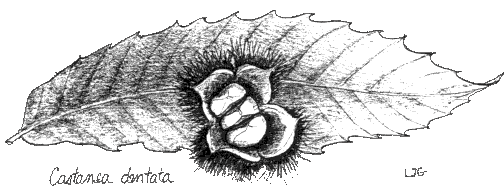American Chestnut Cooperators' Foundation
|
|
American Chestnut Habitat
|
|
|
|
|
| The graphic shows the range.... Eastern North America, from Mississippi to Maine mostly on the spine of mountainous uplands that slopes in an upwards, northeasterly direction from the Southland. Today as we prowl the forests, its hard to think in the past tense and visualize that Castanea dentata, the American chestnut, now nearly gone, was dominant. In many forests it was the most numerous and often the largest tree. | |
| Today, the American chestnut is found in dry woods throughout the natural range, from Maine and Ontario west to Michigan and south to Georgia and Mississippi, where determined sprouts continue to grow from stumps and roots of long vanished giants. The large forest tree reached heights over 100 feet, growing in rich woods. American chestnut was the hallmark of the Eastern woodlands. It was adaptable to a variety of habitat situations and grew faster than most other hardwood trees in the forest, about as rapidly as the tulip poplar. In the open, the chestnut had a spreading crown up to 100 feet wide and cast shade around its base as wide as the upper branches extended. In forest settings, its shape resembled the tulip poplar. It grew well in soils that were poor and shallow, as well as those that were deep and fertile, wherever soils were not limestone-based or poorly drained. The chestnut grew on slopes in Southern Mountains at altitudes over 4,000 feet. It was common on the slopes between 2,000 and 4,000 feet. | |
|
Ideal American Chestnut Revival Habitat |
|
| Restoration projects (managing for American chestnut in aging clearcuts, or introducing improved blight resistance by grafting scions into available root systems or planting seedlings on former American chestnut lands) should concentrate on carefully selected sites which do not include the whole spectrum of choices mentioned above. Because the American chestnuts will be repeatedly challenged by blight, it is important to choose sites which avoid all other environmental stresses, as much as possible. These sites can be identified by the presence of large chestnut stumps or snags, chestnut sprouts, and other species that share similar site preferences, such as tulip poplar, northern red oak, and cucumber magnolia. Frequently, the best chestnut sites are located in shallow coves and slopes facing north to east. Dry sites should be avoided to limit stress by drought. Known frost pockets or cold air drainage routes should also be avoided, and lower elevation sites are generally preferable to sites over 2,000 or 3,000 feet, to minimize the stresses from extremes in temperature during winter. Full morning sun in coves or sloping, well-drained lands with acid soils (pH 5 to 6) are best. When in doubt, consult a professional forester. | |
|
|
|
| Do
you know of a place that fits this description? To learn how to start
an American chestnut restoration project there, go to Growing
American Chestnuts.
Return to American Chestnut Cooperators' Foundation home page. |
|

